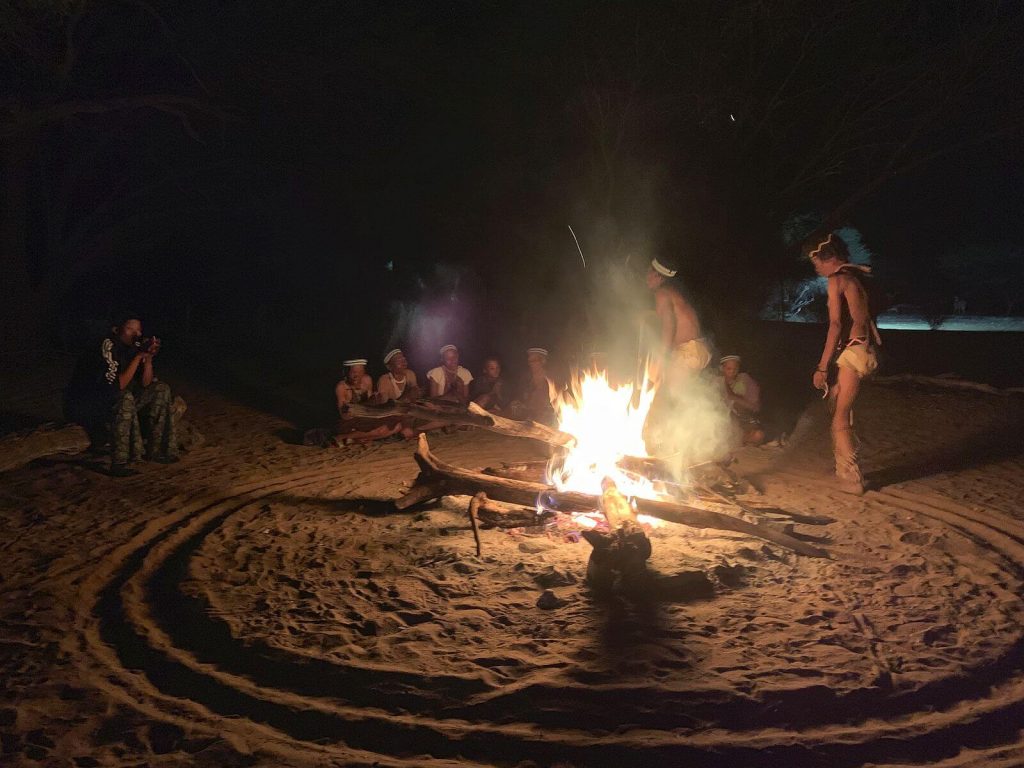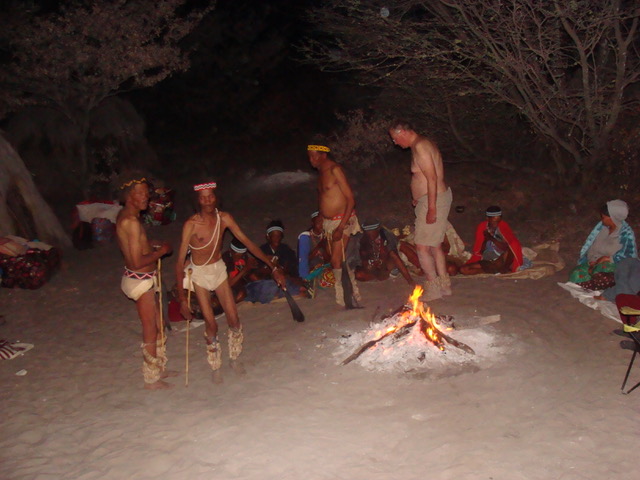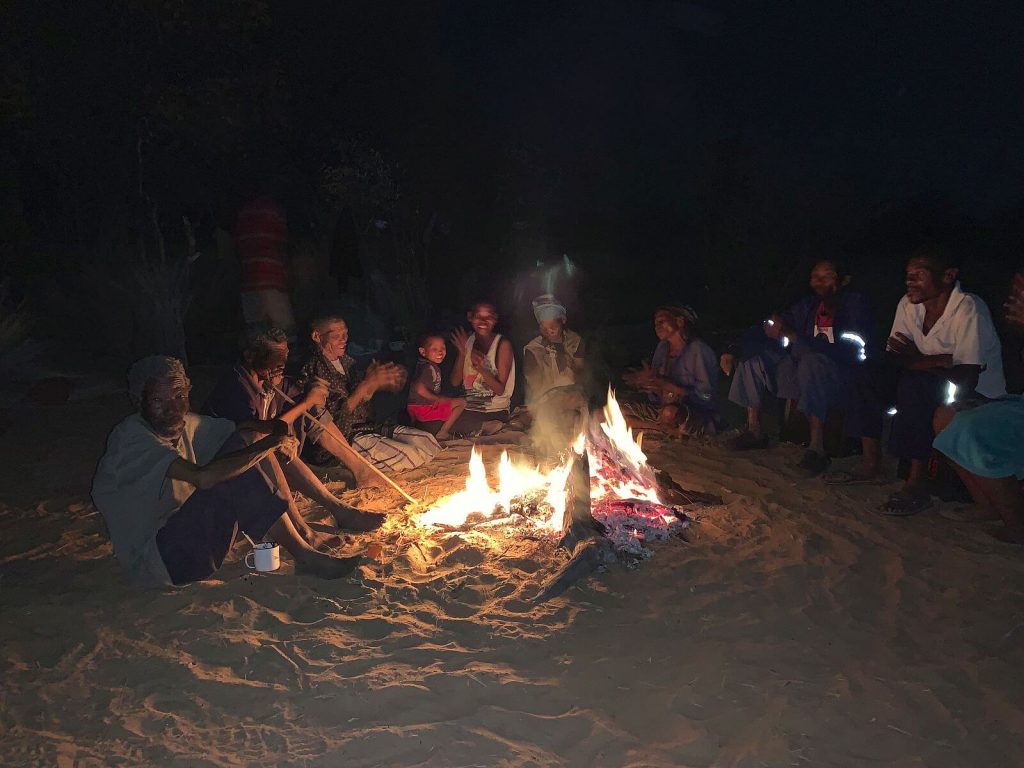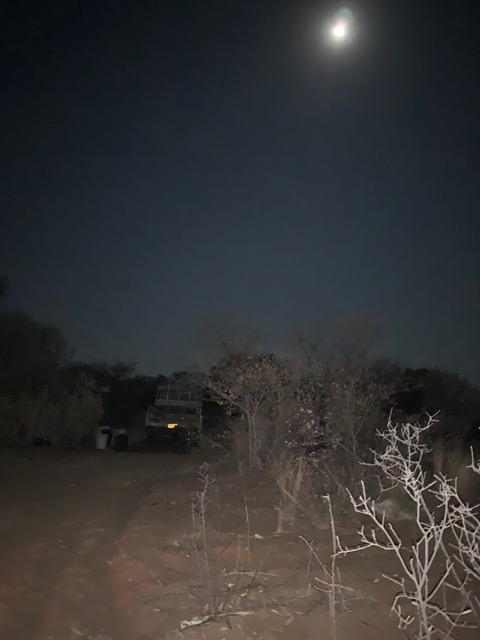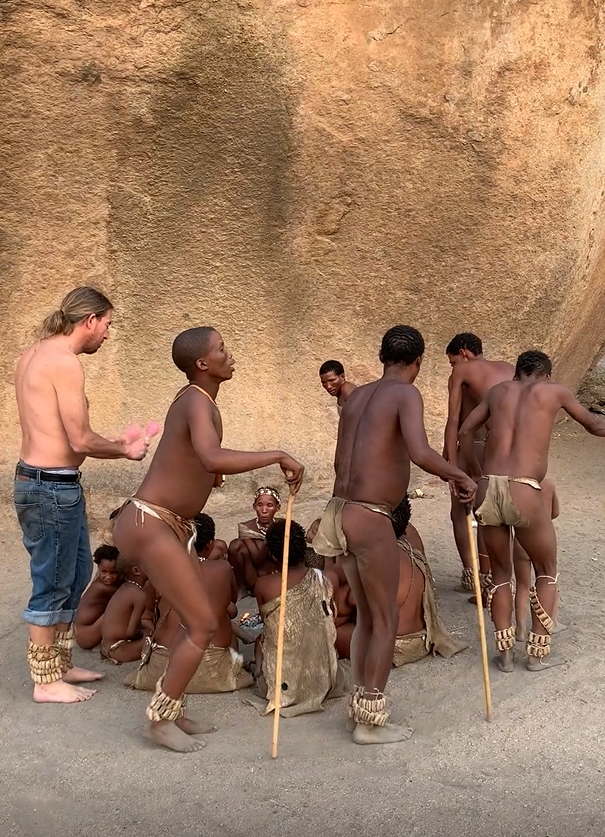
Private presentation dance at Erongo Living Museum
During our two weeks on the road my guide, Gary Trower and I participated in several types of dance, all with slightly different characteristics.
In the Erongo Living Museum in Namibia where Bushmen undress to showcase their handicrafts, dancing and hunting traditions, Gary and I were privileged to join the troupe and their families after tourist hours in an impromptu dance under a magnificent cliff. It was fun for all, a letting off of steam in song and dance.
When we arrived in the Ngae Ngae Bushmen reserve, we took part in our first truly shamanic dance involving healing led by the Shaman Kuntabo. No trance was achieved however.
In the Dqae Qare San Lodge in Botswana we were surprised and pleased when a tourist presentation dance suddenly became the real thing when one of the Shamans performing went into a trance. That was followed two nights later with a real trance dance involving three Shamans in the middle of the Kalahari Desert.
We had our last trance dance on the road south from Dqae Qare in a small clearing at Acagae, a sad occasion as here were old friends of Gary’s living in a state of destitution and marginalization – the fate of many Bushmen today, but the impromptu dance they put on for us, with two shamans under a full spring moon showed that the old traditions still survived. I attach below diary entries related to three of the dances.
Trance Dance 1: Tourist presentation dance
Dqae Qare Lodge , Botswana 10th August 2019
We had camped at exactly the site where Gary had pitched his tent when he lived here 15 years ago. It was a bit of a homecoming. On our arrival at the lodge, stopping there for a beer, the tourists had apparently been amazed when we two disheveled travellers disappeared round the back of the kitchens and were met by screams of delight from the staff , “Gary! Gary!” and then, to their surprise, the sound of singing and an impromptu dance.
We were rather ignored when we joined the tourists at their supper. Only a Dutch lady asked us who we were, and two Japanese ladies, who had ordered a trance dance from one of the lodge’s four dance troupes welcomed us to join them.
It was a lovely setting in front of some trees. Two elderly men with sticks rotated round a big fire while a line of women sat behind them, singing. Gary told me that the older of the two men, Xam, had been an initiate shaman when he had lived here, the other he did not know. The two men shuffled round the fire, slowly shaking their feet and arms and chanting, their voices merging with those of the women. Each dance was different, with a different chant and descant.
It was of course a presentation for tourists, but we suddenly realized how seriously the performers were taking it. Sweat was gleaming on the younger man’s torso. The dance was irregular now as each in turn would stop and provide healing to the women singing. If anything the tempo of the singing had increased. We noticed that the kitchen staff had silently come up and were seated on a log, clapping and chanting with them – and being treated too. The two men placed their hands on a patient’s stomach or shoulders – then moved to another patient or started dancing again. Their movements were wild now. The firelight gleamed on the younger man’s sweat. His eyes were rolling.
Suddenly Xam, the older man, collapsed. The women were still singing, but those closest to him began to support him, their hands rubbing his body. Soon he had recovered but his movements were now strong and deliberate as he moved from one woman to another to lay on his hands.
Everybody’s blood was up now. Finally one of the ladies invited us spectators to join in the last dance – and as we moved around the circle I felt a joy and energy quite equal to that we had experienced at Kuntabo’s village.
“I’ve never seen a trance actually occur in one of these tourist shows before,” Gary told me. “We were lucky. ”
“It wasn’t just an act then?” I asked.
Gary looked at me. “Didn’t you see Xam’s wife cool him with the sweat of her armpit? He’s a shaman. These are sacred songs. Nobody’s acting – even for tourists.”
Trance Dance 2: Private Trance Dance
Dqae Qare Game Park , Botswana 12th August 2019
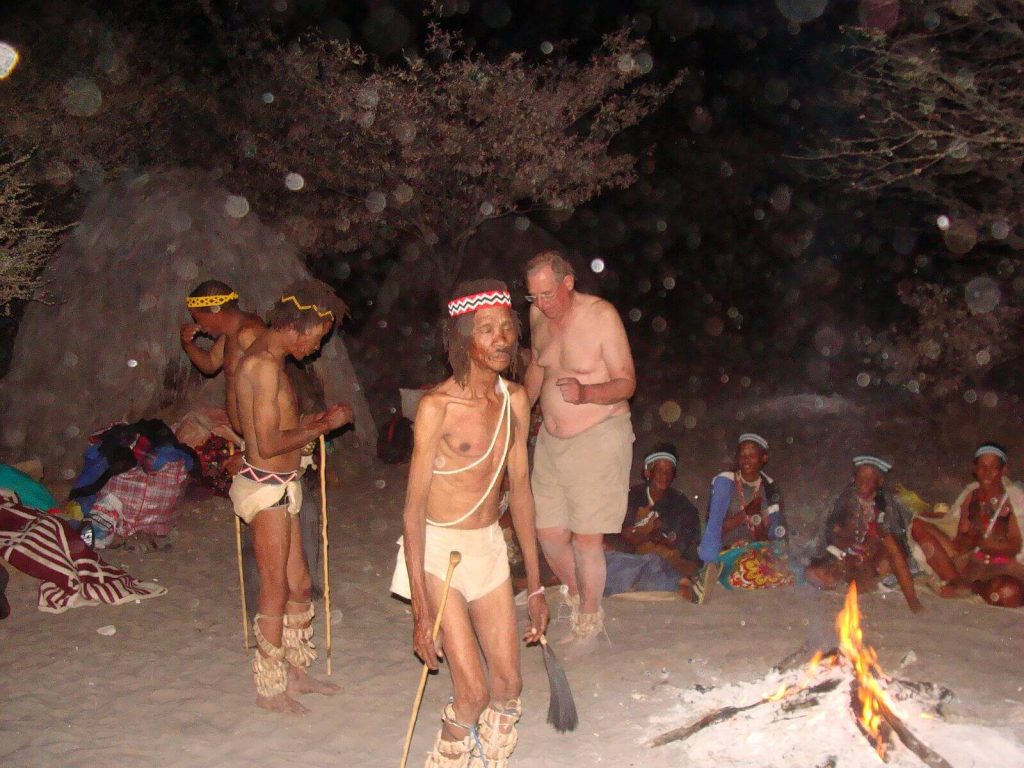
Trance dance at Dquae Quare Game Park– from left shamans Xhara, Qam and Tiger, and Adam (Xhara blowing away poison)
After a busy day of preparation, we returned to camp, brewed coffee, napped and meditated by the fire in anticipation of tonight’s dance. We were due to meet the dancers and singers outside the lodge at 8.00 pm.
The moon was almost full, the Southern Cross and its two pointer stars clear in the sky. The edge of Scorpio was visible behind the trees. From a nearby tourist campsite we heard the high-pitched voice of a storyteller, reciting Bushman fables for tonight’s entertainment.
At 8.00 pm exactly we set off for the kitchens where the shamans and singers waited. Jutas, a white mustached man in a baseball cap, had brought his half truck loaded with wood. There was room in the front for the shamans to sit and enough space in the back for the singers, while we took four of the kitchen staff in our jeep. As they squeezed in they thanked us for allowing them to come along.
Our two vehicles moved together out through the campsite and a gate that led into the game park. In the headlights I could see that we were travelling along pathways of sand with weeds flanked by sparse bushes. The government-imposed hunting ban and the drought had had their effect. Overstocked, the grass had largely gone and resources of the park had been stretched in consequence. We drove for 9 kilometers under the moon, our destination the now unvisited ‘Faraway Camp Site” where we hoped to be entirely private.
However it was not to be. “I knew it,” muttered Gary, for just off the road a white jeep was parked by a fire. A man stepped forward. He wore a pressed white shirt, crisp shorts and shiny shoes below neat white socks, but what distinguished him – very rare in a bushman – was his enormous round belly. I knew who this was – he had been trying to ingratiate himself with Gary several times at the lodge; Gary had been formal and polite but largely ignored his advances, even though Arron was a powerful man in the community, a member of the D’kar Township Council and Chairman of the Board of the Dqae Qare Lodge, the boss in other words. The animosity between the two men went back many years to when Gary lived in Dqae Qare, and had many friends in D’kar. At that time senior officials like Arron had been involved with land deals, which many of the townsmen believed gave advantage to the non Bushman immigrants to the reserve with much money changing hands. Gary had been quite vocal in his denunciation of these practices, pitting himself against the establishment. The result had been nasty, sangomos (Bantu wizards) had issued life-threatening spells, and Gary had had to leave. It was clear that Arron had found out that a private trance dance was being held tonight and was mortified that he had not been invited. He waved as we passed. Behind him we could see his wife and children. “This is no coincidence,” said Gary.
We drove on. About 3 kilometers later we entered a glade consisting of a ring of abandoned grass huts and some thorn trees round a fire circle. The veldt stretched into the darkness on all sides. We were about as far away from anywhere as we could be.
Under Jutas’s direction we moved the wood, and made our own preparations, sorting out what clothes we would wear or lack of them. The singers went into the empty huts to change.
Suddenly the glade was illuminated by new headlights. It was Arron. Gary leaned towards Xhara. “This is a private event.” Xhara nodded. Arron was striding towards us with an expansive smile on his face. Gary and I sat in front of the now burning fire ostentatiously looking at the flames.
It was Jutas who handled the diplomacy: Of course, he told Arron, on any other occasion a man of high position would be most welcome to watch the dance, if it was a lodge occasion paid for by the tourists. He and his family could come free of charge, and his family could receive healing from the shamans. The problem was that this was a private event, paid for – he nodded in my direction – by me, and I had strictly requested nobody else attends. So on this occasion he would not be welcome. Sorry.
He tried to keep his dignity. He even smiled and waved, as he walked back to his car – but his rigid back showed his fury. “Let’s hope he didn’t bring a sangomo,” said Gary, “though I don’t think he’d dare go up against Quara.”
But we soon forgot him. Soon all was ready. The fire was in high flame. The women, already sitting in a line along one side of the circle, began to sing. The three shamans – Xhara, who would lead the dance, Xam, who had tranced in the presentation dance two nights before, and Tiger, whose skeletal body revealed his advanced state of tuberculosis – had already stripped off their clothes to their loin coverings, each held a staff, and they all wore headbands. The singers, seven women of all ages, wore blue headbands, and necklaces, and had changed to their presentation costumes, but all had brought their own cloaks and jackets against the cold, so they presented a brightly colored array. The four kitchen staff had sensibly brought cloaks and blankets against the cold. They too were desultorily swaying, clapping and singing.
Gary was meanwhile making his frankincense potion using a coal from the fire. When it was smoking he took the fragrant charm round the circle for all to breathe – they did so seriously. Then we tied our rattles to our calves (mine, bought at the handicraft store, seemed very skimpy compared to the others’ knee high affairs) and stepped up to dance.
Immediately, stripped to my shorts, I felt the heat of the fire on my belly and chest. Xhara shouted something. The women clapped in unison and began to sing “oh oh oha oh, oh ooh ah” some breaking off into high-pitched descants. The men were shaking their leggings in time to the claps, injecting into the women’s singing barks and grunts of their own. Led by Xhara they began to circle the fire. The dance had begun.
There was an immediate release of energy. From the beginning this dance was charged. It was a combination of everything: the singing, the clapping, the shouts of the shamans – but it was also the physical setting itself: the moon lit glade, the moon itself high in the sky, as if it were presiding over the activities below, and the sheer distance away we were in the veldt. This might have been our private world. Most dramatic of all was the eagerness of the singers and dancers. It was no polished dance for the public. Those who had come here today had come for healing. And how privileged was I? Three Shamans! Four, counting Gary as another healer (Xhara treated him like his assistant).
Xhara, leading the dance, seemed to have magnified in height and strength. His loud voice and sheer presence dominated. Tall Xam, with his curly grey hair, was quieter, concentrating on his steps. The skeletal Tiger, despite his ravaged face and shaggy dreadlocks, nevertheless had an elegance and panache, which distinguished him from the others. He was a fine singer. A healer who apparently never went into trance, he had come despite his illness, at Xhara’s persuasion, perhaps to receive healing as well as to offer it. And Gary danced unconventionally, keeping time however with both hand rattles and leg rattles.
It must have been 9.30 pm by the time we started. Slowly, during those first few songs we shuffled along in a line, the shamans’ feet beating hard on the sand. I tried to follow but the rhythm came to me with difficulty. Even so, from the beginning, I felt included and focused. The roaring flames baked our legs, and half naked as I was I soon began to sweat. My stomach and chest heated up, it seemed as much from the inside as the outside, but I was full of energy and soon my stiff body began to relax. Shuffle rattle shuffle rattle, listen to the claps, listen to the shake of feet, follow the song … I was totally aware, but at the same time I felt half hypnotized by the regular movement.
The voices, not only of Xhara, but also increasingly, of Tiger, began to bark with more urgency. The circling occasionally ceased as the shamans danced in place, heads looking up at the sky. One by one they slipped out of the dance to put their hands on the singers’ heads and shoulders, followed by those of the kitchen staff.
Then Xhara returned to the circle. For a while he (and I) were the only ones dancing. He was moving faster however and occasionally gesticulating. He suddenly straightened, then peered, then marched deliberately towards a woman, in whose body he had spotted an illness. He leaned fully over her pressing his hands on her upper chest. His voice increased in volume as he returned to the circle.
Then I saw it happen.
He stopped, straightened to his full height and stood dead still, for a long moment gazing into nowhere. He had gone into trance.
He began to move deliberately again, then he staggered. Xam came up behind him and steadied him, pressing his hands against his back to calm him, as Xhara began to administer to the women again. He made as if to stand up, then fell forward. The women near him held him, stroking him, trying to soothe him, whilst his whole body shook. Others took sweat from their chests and armpits to cool him. He was clearly in full trance. Suddenly he broke away, resisting them, and stood up, his eyes staring. If anything he seemed larger and taller than he had been before, and certainly firmer of purpose. He marched like Captain Dauntless towards his next patient.
He would lay on his hands, press, mutter, then stride away again to the side of the circle, putting his flat palms at right angles to his mouth, and blowing the evil and sickness that he had extracted far away into the trees. He would peer after this invisible substance watching it dissipate or disappear, and only when he was satisfied it was gone would he march back into the fray.
The others were also administering to patients, one pressing his hand on the stomach of a pregnant woman, others pressing heads or shoulders, from front or behind where access would be best to the particular illness. The women closed their eyes, losing themselves in the treatment – then after the shaman had gone they would resume their clapping and singing with a will.
Gary meanwhile was supporting the healers to drive away the disease by shaking his two hand rattles over their bodies.
Once Xhara came to me. I stood rock still. He pressed his hot hands to my two sides, strangely in exactly the same place that Kuntabo had pressed his hands a few nights before. I had felt nothing then – I still have no idea what was wrong with my sides – but I did feel more energy, and maybe less of an ache, when Xhara lifted his hands. I immediately relaxed, the tightness in my stomach had gone. He certainly believed he had drawn something out of me, because he went to the side of the circle again and blew whatever it was into the night.
I had no idea what the time was. I guessed that for at least an hour more healing had been going on than dancing, though the song was relentless. Often I found myself the only dancer round the fire, watching with fascination as the shamans administered, but also trying to keep the rhythm, the rhythm.
Eventually I realized that I had exhausted myself, and that I was thirsty. Rather guiltily, I quit the ring and sat down – but I was shortly followed by the others. The dance had lasted maybe two hours or even three hours, I could not tell. It was time to relax, smoke, talk round the fire. Soon tobacco was handed out, and other refreshments. There was much laughing, with clapping and snatches of song.
I was wrong. The dance was not over. Almost immediately the desultory clapping and song regained full force as one of the shamans got up and danced again, followed by the others. I joined them, and this time to my surprise discovered that all my difficulties with the rhythm had disappeared. I was immediately had become attuned to the claps, the rattles, the songs, which first enveloped, then propelled me. I was now thumping my feet in time with the others, my rattle sound joining theirs.
The shamans had taken up where they had left off, and continued with their healing, and Xhara was in trance again. Again there was the deliberate search for sickness in the circle. I circled the fire and watched. I saw Xhara and Tiger in a tight embrace. Xhara pressed his whole body against that of his friend, pouring all his energy into him in an attempt to tackle the tuberculosis. I sensed this was no ordinary healing, and was much moved.
I plodded on round , keeping to the rhythm, feeling the heat of the fire eating into my legs and chest – but the songs just propelled me onwards.
After a while I realized that all three of the shamans and Gary were concentrating on one older lady – one of the four kitchen staff who had asked to attend. They looked like surgeons huddling over the operating table. Bending over her their hands were pushing and rubbing her legs. Whatever it was it was serious. Gary later told me that examining her the shamans had realized that this was no ordinary sickness or disease. It was sorcery. They had discovered a needle in her foot. This was one of the weapons that sangomos (Bantu wizards) invisibly blow into their victim’s body. Passing up to the heart it can cause a stroke or death. I had no idea that this was the case when I danced but I felt the urgency and tension. All the while the women sang and clapped.
I don’t know how long we had danced – time had become rather lost by now – but I began to feel dozy, and also parched. I remembered I had left a bottle on the sand by my discarded clothes.
I sat watching. The three shamans were all dancing together now, and I could examine their feet and body movements as I had not been able to do when I was dancing myself, and slowly I began to appreciate the sheer beauty and complexity of each dance. Each step was carefully chosen as if it had been choreographed, but frequently changing, sometimes one leg over the other, sometimes the body movement making the legs zigzag. The upper body also seemed to be moving to some pattern, which changed from dance to dance. Also all three of them, despite their different ages and frailties, were moving in tandem. For the first time I felt I could see the animal they were imitating or invoking – and I remembered how at the end of the dance in Namibia I had felt such energy when I began to imitate the gait and neck movement of a giraffe. In turn they danced now what I was later told was the Dance of the Oryx, the Lion, and even the Calabash (a vegetable). And it was beautiful. I began to wonder if they somehow felt that the spirit itself of the animal was inside them.
After a while I dozed, my mind perhaps lulled by the song. I woke up freezing. Jutas had gone off for a nap and the fire had died down. While the shamans still danced, the central blaze had dwindled to some flames over the ashes. Certainly no heat was reaching me where I lay on the cold sand. I could still have sat there watching them dance with the same fascination as before, but I forced myself up, knowing that staying there would be the way to pneumonia. I made my way back into the circle, following the shamans round the fire, or going round slowly by myself, at one with the song.
I felt a tug on my arm. Gary was pointing urgently at the sky. “Look, look.” As we watched a shooting star arced down towards some point way beyond the treetops. Its head was a huge fiery ball, its tail a streak of blue light. I had never seen a shooting star so close, or so beautiful.
Eventually the dance ended, and we all sat down again, more cigarettes were passed round, the shamans began to chat, the women to huddle under blankets.
I looked up at the sky. The moon had been right above us when I had last looked. Now it was positioned far away and lower in the sky. The stars seemed to burn brighter than before. It turned out that we had been dancing for six and a half hours. When I recovered my watch from the pocket of my discarded trousers it read 3.20 in the morning.
Slowly we gathered ourselves. Somehow I found all my clothes..I sensed Xhara behind me, pointing, and I saw that where I had changed back to warmer gear, I had left my shorts on the sand. Then I remembered, Xhara always seemed to appear when you needed him. He saw and anticipated everything.
We drove back slowly over the veldt, now illuminated by the stars.
Trance Dance 3: Local Trance Dance
Acagae, Botswana 14th August 2019
It had been a long drive down a straight road south, with signposts to the next towns marked in hundreds of kilometers. Along the way we had seen several animals – kudu, ostriches, springbok, jackals and the ubiquitous guinea fowl. The veldt stretched endlessly on both sides of the highway, sometimes bushy, sometimes grassland.
It was on a bushy stretch that Gary said suddenly. “We’re about to reach Acagae. I’ll bet you it’ll be my friend, Punch, who spots us first. He always does.” There is nothing in Acagae, he told me, but a small Bushman camp, where years ago he used to stay when he worked for Ghanzi Art and Crafts. The shaman there was Kayake, Punch was his best friend.
But Punch was not there to meet us. A knot of young men standing by the side of the road crowded round the car where we had stopped, flocking round us with cries of “Gary” but it rapidly became clear that this was not a greeting of an old friend but demands for the candy man to give them money, cigarettes and liquor. “Where’s Punch?” Gary asked in frustration. A young man grinned and pulled his finger across his throat. “He’s gone. Died. Last year. Have you cigarettes?”
For the first time on this trip, Gary, without offering any gifts, pulled away from a crowd, turned and drove back up the highway towards the entrance of Kayake’s encampment that somehow we had missed. “I don’t know any of them,” he said. In his side mirror he spotted an old woman walking along the side of the road pulling a large log. “Looks as if she needs help though.”
She turned out to be Boitso, Kayake’s wife. My first impression was of somebody slightly deranged. “Gary,” she said, savoring the name, then added inconsequentially, “Money.”
With the log loaded in the back, we turned off the road and drove through the trees soon reaching a glade where some ragged old men and women, with a few younger ones and several children were sitting. There were a few ramshackle huts and sheds set up on one side.
Kayake, a bearded, dignified man, stood up and stretched out his hand. “Gary,” he whispered with affection. Another old man, with frizzy white hair, stood beside him. These were the two shamans of the village. Gary hugged them and told them he had come to organize a trance dance. A murmur of pleasure rippled round the ring of people.
“Have you some liquor?” asked Kayake confidentially, motioning the shape of a bottle. Gary looked shocked. “No, “ he said. “No liquor. A trance dance.”
I felt very sad. Clearly, since Gary was last here, the lives of these people, marginalized already, had deteriorated, along with their sense of pride, and an increasing dependence on alcohol – but Gary remained purposeful. “We’re having a trance dance,” he said. “Come, who will help me gather wood?”
With one of the younger men we drove the car back to the road, having emptied the back of some of our equipment and luggage to make room. I looked up at the sky. In the East a pale moon was rising, a full moon. In the Western sky the sun was sinking, a huge red ball. A full moon and a full sun in the sky at the same time: it seemed like an omen. This, in the Bushman cosmology, was the fullness of the moon that marked the transition between winter and spring.
It took some time and much effort to find the right sort of hard, non-smoking wood we required for our fire. Some likely grey stumps, though already dead and dry were too firmly rooted for us to pull out, and so hard that they were resistant to a hatchet. So we wandered further and further into the bush, and it was only when the sky was darkening, the sun long gone and only a red rim of light divided the dark and the highway, that we emerged again with enough kindling to make a fire. We heaved the heavy tangled branches into the back of the car. It was already fully dark by the time we got back to the camp.
And there, to my surprise and relief, I found the small place throbbing with excitement. A small fire had already been lit. We stacked the new branches on top and it began to blaze high.
The women were already sitting in a line – only five of them, including Boito and a young woman in her twenties, clearly very drunk, but lively and happy with it. They were already testing out their songs.
The older men had strapped on their leg rattles. There was no question of stripping to loincloths. Here, everybody danced in their own clothes.
The excitement only grew as Gary went through his routine with his frankincense, blessing first his rattles then each of us in turn. The two shamans solemnly breathed in the incense. The women’s voices were already rising, their hands were clapping: the dance was on.
It was very small scale compared to the other dances we had attended in Tsumkwe and Dqae Qare, but no less authentic or intense. Again I joined in. Kayake was soon in trance, and then the other man seemed to trance too. The healing process began, aided by Gary. There was much work to be done on the drunken girl. Hot hands were placed on her shoulders and the back of her head, and much evil odor was blown away into the bush afterwards.
The elder, white haired shaman, caught me, and hissing, chanting, ran his hot hands over my chest and heart. Eyes rolling he made a sort of clucking sound and then, job done, he stepped away, blowing the poison he had taken out of me into the bushes, before going on to Gary to do the same.
There was something very intimate about this dance. It was almost casual, a family affair. The shamans sat down often. There were long pauses. People came and went. A child sat down and cuddled against the drunken young woman. The moon meanwhile shone on our little glade, blessing us with the first night of spring. It was a lovely, quiet dance to end my journey on.
Sad too, because in a way it was also an epitaph for Punch, and other friends long gone. I did not see much future for this small group, living by the side of the road.
We ended the dance shortly after 9 pm. We still had two hours to drive before the nearest rest stop in Kang. We doled out the last of our gifts. Seeing the tattered condition of Kayake’s shoes, I gave my new gym shoes to him. I had intended to give my blanket to the old woman, but I saw the grey haired shaman looking longingly at it. In the event Kayake took it, Noblesse oblige. Gary laughed and gave me a sack of dough. “Give this.” So honour was done for both shamans!
We left them laughing and still singing by the fire, happy with their gifts and the chance to do what they loved: to dance, but I still felt a melancholy as we pulled away. Punch was dead. So were the two healer ladies Gary had danced with before in Namibia. One of his teachers in Dqae Qare was paralyzed and he may not see her again. Tiger had tuberculosis, the same disease that killed Punch. We had again, it seemed, witnessed the dying spark of a culture and way of life. During the night drive the road seemed haunted as animals emerged spectrally to graze under the full moon. It was dangerous driving as any of them might have stepped out onto the road. We saw huge hartebeest, big kudu, springbok, several jackals and once or twice an aaswulf – an insect-eating hyena. It was as if shadowy figures from the trance dance had been called out of the darkness.
To be continued …
